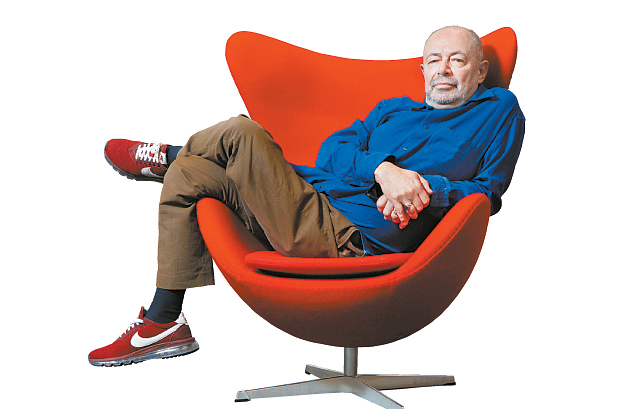Putting people and nature first in urban design

Italo Rota sits in the “Egg Chair” designed by Arne Jacobsen from Fritz Hansen. [PARK SANG-MOON]
“Everyone is different in their own way and what they value can also differ, and I have no problem with that,” said Rota. “What is important for me is that whatever trashcan you’ve picked up, that it makes you happy.”
That is why, when asked about his design philosophy, Rota answered right away that he prefers to work around designing a service for people, rather than an object.
“You can be more innovative and experiment [with] new things when designing services for people and use every day to give small but new contributions to people’s lives,” he said. One example of such work will be the coal-fired thermoelectric power plant in Saline Joniche, southern Italy, which will revitalize an industrial site and structure abandoned in the 1970s, converting it to an energy center and rejuvenate the port area.
“I like to build very strong industrial factories in the center of the city,” said Rota. “The factories will be completely [eco-friendly]. I try to design strategies that can tackle urban problems that can regenerate life in the city center where things like tourism, companies, restaurants and financial institutes dominate.”
To share his design philosophy with Koreans, Rota visited the Dongdaemun Design Plaza as a featured speaker at the first DDP Knowledge Sharing Seminar that was held June 8 at the DDP in central Seoul. Under the theme, “Interior of an Interior, From an Object to the Megapolis,” Rota spoke to some 300 participants who registered online for this free seminar organized by the Seoul Design Foundation. Prior to the seminar, the Korea JoongAng Daily sat down with the 63-year-old designer for an interview. The following are edited excerpts.
Q. What’s the current trend in design? You seem to focus on people-oriented and ecological design.
A. Well, first of all, whether it is ecological or not is important, but [it is not the only thing]. No matter how many ecological products you have created, if it does not get used and thrown out into nature, it makes no sense. The important question to first ask is whether it is necessary to make it ecological. And sometimes, if you try to focus too much on the people, it can contradict with being ecological. Moreover, I don’t believe in trends. For me, a trend doesn’t exist. Everyone is different and they like different things. That’s the beauty of human beings and that is why there are such diverse designs that appeal to different people.
You seem to stress that new designs are not always the best designs and that new creations can be made using what’s already there. Can you elaborate on that?
There’s already too many buildings here and there that we have entered a critical phase in the occupation of space on this planet. We should learn to use the spaces we have more efficiently instead of building new ones. The issue is no longer that of coming up with aesthetically beautiful designs or ecological designs. What designers should think about is knowing how to listen to the world of objects and making them communicate with people. It is important for me that there’s a narrative content in a design object. Every design has to allow users to build an empathetic relationship and that it has to speak to the users.
You haven’t done any design projects with Korea yet. If you could work on something in Korea, what will it be?
If I could, I would like to work in Korea, with Korean people, as I have passion for Koreans. Together, I hope to build a new solution for the city of Seoul. I don’t mean building new buildings or new objects but to use something that’s already there. For example, in Seoul, you have many trees but you don’t have gardens. So why not work around this? Using the trees and building something around it right in the heart of the city, we can make people happy, and allow people to learn more about the nature and creatures that live among it. What was interesting for me here in Seoul is that you have so many different kinds of greens and mushrooms in supermarkets. Why not allow people to see all of them in the city?
BY YIM SEUNG-HYE [sharon@joongang.co.kr]










with the Korea JoongAng Daily
To write comments, please log in to one of the accounts.
Standards Board Policy (0/250자)